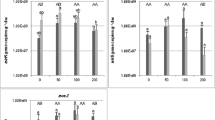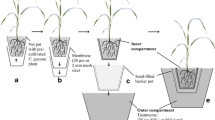Abstract
Two experiments have been conducted, one in semi-solid Hoagland nutrient medium and the other in shallow pots containing saline soil. N2-fixing bacteria belonging toAzospirillum, Azotobacter, Klebsiella andEnterobacter were inoculated separately on kallar grass grown in semi-solid nutrient medium. It was shown that inoculation affects root proliferation and also results in15N isotopic dilution. The % Ndfa ranged from 47–70 whereas no significant effect on the total nitrogen uptake was observed. The bacterial colonization of the root surface and the presence of enteric bacteria inside the root hair cells is reported. In a soil pot experiment, non-N2-fixingPolypogon monspeliensis was used as a reference plant (control). A treatment receiving a high rate of nitrogen was also used as a non-N2-fixing control.15N-labelled ammonium sulphate at 20 kg N ha−1 and 90 kg N ha−1 was used. The % Ndfa in the aerial parts of kallar grass was 12–15 whenP. monspeliensis was used as reference plant whereas 37–39% Ndfa was estimated when the treatment receiving high nitrogen fertilizer was used as a non-N2-fixing control. These investigations revealed some problems of methodology which are discussed.
Similar content being viewed by others
Reference
Aleksic Z, Broeshart H and Middleboe V 1968 The effect of nitrogen fertilization on the release of soil nitrogen. Plant and Soil 29, 474–478.
Bilal R and Malik K A 1987 Isolation and identification of a N2-fixing zoogloae forming bacterium from Kallar grass histoplane. J. Appl. Bacteriol. 62, 289–294.
Boddey R M, Chalk P M, Victoria T L, Matsui E and Döbereiner J 1983 The use of the15N isotope dilution technique to estimate the contribution of associated biological nitrogen fixation to the nitrogen nutrition ofPaspalum notatum cv batatais. Can. J. Microbiol. 29, 1036–1045.
Bremner J M 1965 Total nitrogen.In Methods of Soil Analysis. Eds. C A Black et al. pp 1149–1178. American Society of agronomy, Madison WI USA.
Chalk P M 1985 Estimation of N2-fixation by isotope dilution: An appraisal of techniques involving15N enrichment and their application. Soil Biol. Biochem. 17, 389–410.
Cohen E, Okon Y, Kiegel J, Nur I and Henis Y 1980 Increase in dry weight and total nitrogen content inZea mays andSetaria italica associated with nitrogen fixingAzospirillum spp. Plant Physiol. 66, 246–249.
Fried M and Broeshart H 1975 An independent measurement of the amount of nitrogen fixed by a legume crop. Plant and Soil 43, 707–711.
Fried M and Middleboe V 1977 Measurement of amount of nitrogen fixed by a legume crop. Plant and Soil, 713–715.
Giller K E, Wani S P and Day J M 1986 Use of isotope dilution to measure nitrogen fixation associated with roots of sorghum and millet genotypes. Plant and Soil 90, 255–263.
Haahtela K, Laakso, T, Nurmiaho Lassila E L and Korhonen T K 1987 Effect of inoculation ofPoa pratensis andTriticum aestivum with root associated N2-fixingKlebsiella, Enterobacter andAzospirillum. Paper presented at the 4 th International Symp. on N2-fixation with non-legumes. Rio de Janeiro, Brazil Aug. 23–28, 1987.
Kapulnik Y, Sarig S, Nur I, Okon Y 1983 Effect ofAzospirillum inoculation of yield of field grown wheat. Can. J. Microbiol. 29, 895–915.
Legg J O and Stanford G 1967 Utilization of soil and fertilizer N by oats in relation to the available N status of soils. Soil Sci. Soc. Am. Proc. 31, 215–219.
Malik K A and Zafar Y 1985 Quantification of root associated nitrogen fixation as estimated by15N isotopic dilution.In Nitrogen and the Environment. Eds. K A Malik, M I H Aleem and S H M Naqvi. pp. 161–171. Nuclear Institute for Agriculture & Biology, Faisalabad.
Malik K A, Zafar Y and Hussain A 1980 Nitrogenase activity in the rhizosphere of kallar grass. Biologia 26, 107–112.
Malik K A, Zafar Y and Hussain A 1981 Associative dinitrogen fixation inDiplachne fusca (Kallar grass).In BNF Technology for Tropical Agriculture. Eds. P H Graham and H C Harris. pp. 503–507.
Malik K A, Zafar Y, Bilal R and Azam F 1987 Use of15N isotope dilution for quantification of N2-fixation associated with roots of Kallar grass (Leptochloa fusca (L.). Biology and Fertility of Soils. 4, 103–108.
Malik K A, Bilal R, Azam F and Sajjad M I 1988 Quantification of N2-fixation and survival of inoculated diazotrophs associated with roots of Kallar grass. Plant and Soil (In press).
Miranda C H B and Boddey R M 1987 Estimation of biological nitrogen fixation associated with 11 ecotypes ofPanicum maximum grown in N-15 labeled soil. Agron. J. 79, 558–563.
Nohrstedt H O 1984 Carbon monoxide as an inhibitor of N2-ase activity (C2H2 reduction) in control measurements of endogenous formation of ethylene by forest soils. Soil Biol. Biochem. 16, 520–526.
Okon Y and Kapulnik Y 1986 Development and function ofAzospirillum-inoculated roots. Plant and Soil 90, 3–16.
Patriquin D G, Döbereiner J and Jain D K 1983 Sites and processes of association between diazotrophs and grasses. Can. J. Microbiol. 29, 900–915.
Reinhold B, Hurek T, Niemann E G and Fendrik I 1986 Close association ofAzospirillum and diazotrophic rods with different root zones of Kallar grass. Appl. Environ. Microbiol. 52, 520–526.
Rennie R J 1979 Comparison of15N aided methods for determing symbiotic dinitrogen fixation. Revue D'Ecologie et de Biologie du Sol 16, 455–463.
Rennie R J 198015N-isotope dilution as a measure of dinitrogen fixation byAzospirillum brasilense associated with maize. Can. J. Bot. 58, 21–24.
Rennie R J, Rennie D A and fried M 1978 Concepts of15N usage in dinitrogen fixation studies.In Isotopes in Biological Dinitrogen Fixation, pp. 107–130 International Atomic Energy Agency, Vienna.
Vlassak K, Herman K A H and van Rossen A R 1976 Dinoseb as a specific inhibitor of nitrogen fixation in soil. Soil Biol. Biochem. 8, 91–93.
Witty J F 1983 Estimating N fixation in the field using15N labelled fertilizer: Some problems and solutions. Soil Biol. Biochem. 15, 631–639.
Yoshida T and Padre B C I 1977 Transformation of soil and fertilizer nitrogen in paddy soil and their availability to rice plants. Plant and Soil 47, 113–123.
Zafar Y and Malik K A 1984 Photosynthetic system ofLeptochloa fusca (L.) Kunth. Pak. J. Bot. 18, 109–116
Zafar Y, Ashraf M and Malik K A 1986 Nitrogen fixation associated with roots of Kallar grass (Leptochloa fusca L.) Kunth. Plant and Soil 90, 93–106.
Zafar Y, Malik K A and Niemann E G 1987 Studies on N2-fixing bacteria associated with the salt tolerant grass,Leptochloa fusca (L.) Kunth. MIRCEN J. 3, 45–56.
Author information
Authors and Affiliations
Rights and permissions
About this article
Cite this article
Malik, K.A., Bilal, R. Survival and colonization of inoculated bacteria in kallar grass rhizosphere and quantification of N2-fixation. Plant Soil 110, 329–338 (1988). https://doi.org/10.1007/BF02226813
Issue Date:
DOI: https://doi.org/10.1007/BF02226813




